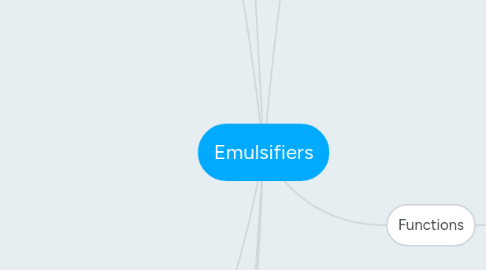
1. How it works?
1.1. It works by reducing surface tension between the two immiscible phases due to their molecular structure. They have polar hydrophilic heads and non-polar hydrophobic tails.
1.1.1. Polar heads may consist of anionic, cationic, amphoteric, or nonionic functional groups.
1.1.2. Lipophilic tails are composed of C16 (palmitic) or longer fatty acids.
2. Types of Emulsifiers
2.1. Nonionic
2.1.1. Nonionic emulsifiers consist of uncharged molecules relatively insensitive to effects of pH and salt content. It is the most widely used emulsifier type. Examples: mono- and di-glycerides, sorbitan esters, sucrose esters, polyoxyethylene glycol oleates.
2.2. Anionic
2.2.1. Emulsifiers that possess a negative electrical charge. Its functionality may be markedly influenced by pH and ionic strength. Examples: Stearoyl lactylates, diacetyl tartaric esters of monoglycerides (DATEM), succinylated monoglycerides.
2.3. Cationic
2.3.1. Emulsifiers that have positive electrical charges. It is not used as food additive due to its toxicity. Example: amine compounds.
2.4. Amphoteric
2.4.1. Emulsifiers that possess both positive and negative charges. Its functionality depends on pH of the system. May act as anionic or cationic emulsifiers Example: Various types of lecithins
3. Hydrophilic-Lipophilic-Balance
3.1. Expresses the balance of size and strength of the hydrophilic and the lipophilic groups on emulsifier.
3.2. High HLB values(>10) indicate relatively polar (hydrophilic) molecules. HLB values from 1-10 indicate that the emulsifiers are more lipophilic.
3.3. Used to describe the emulsifying properties of nonionic emulsifiers.
3.4. HLB values: 1. 3-6: A good w/o emulsifier 2. 7-9: A good wetting agent; can be used for either w/o or o/w emulsions. 3. 10-18: a good o/w emulsifier.
3.5. Formula
3.5.1. HLB= HM/TM X 20 Where, HM= hydrophilic molecular part TM= Total molecular weight
3.5.2. HLB= H/5 Where, H= hydrophilic part(%)
3.5.3. HLB= 20 (1- (Sv/Av)) Where, Sv= Saponification value Av= Acid value
4. Properties of Common Food Emulsifiers
4.1. mono- and di-glycerides
4.1.1. -most commonly used emulsifiers in bakery products, frozen desserts, icings, topings, and peanut butter. -highly lipophilic with HLB values in the range of 1-10 -produced by transesterification of glycerol and triglycerides
4.2. Sucrose Esters
4.2.1. -approved in 1983 -are the mono-, di- and tri- esters of sucrose with fatty acids -usually with HLB values of 7-13 -Applications: 1. Mono-esters(HLB>16) are used for o/w emulsions. 2. Di-esters are good for o/w emulsions. 3. Tri-esters have HLB approximately to 1.
4.3. Sorbitan Esters
4.3.1. -Sorbitan monostearate is the only sorbitan ester approved for food use. -produced by reaction of sorbitol with stearic acids -commercially known as Span 60 - HLB= 4.7 -used in conjunction with polysorbates in oil toppings, cake mixes.
4.4. Polisorbates
4.4.1. -formed from the reaction of sorbitan esters with ethylene oxide
4.5. Polysorbate 60
4.5.1. -Polyoxyethylene sorbitan monostearate / TWEEN 60. -HLB= 14.9 - sample applications include oil toppings, cake mixes, and cake icing
4.6. Polysorbate 65
4.6.1. - Polyoxyethylene sorbitan tristearate or TWEEN 65. -Permitted for use in ice cream, frozen custard, ice milk.
4.7. Polyoxyethlene sorbitan monooleate
4.7.1. -TWEEN 80 - HLB= 15.0 - some special applications are for oils in special dietary foods, vitamin-mineral preparation, and fat soluble vitamins.
4.8. Stearoyl Lactylates
4.8.1. - ionic emulsifiers -possibly the most hydrophilic emulsifiers used in food -lactic acid ester of monoglyceride with sodium or calcium - form strong complex with gluten in starch -especially valuable in bakery products
4.9. Lecithin and Derivatives
4.9.1. -amphipilic emulsifiers -mixture of phospholipids -rich in egg yolks -derived commercially from soy beans -can be chemically modified to provide wide range of HLB values -widely used in baked goods, low-fat baked boods, chocolate, infant foods, confectionery products, and cooking spray.
